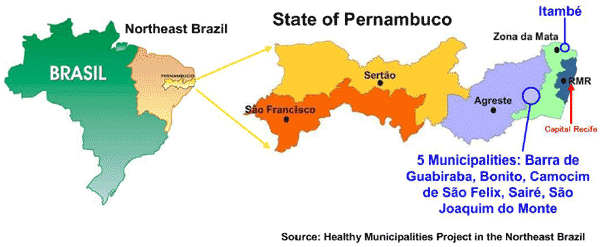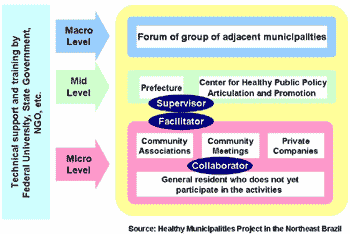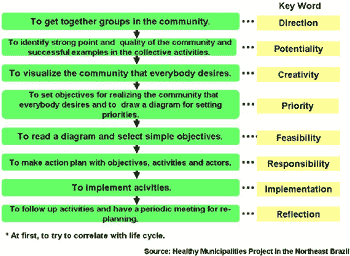- Home
- Technical Cooperation Projects
- Index of Countries
- Latin America
- Brazil
- The Healthy Municipality Project in the Northeast Brazil
- Project Activities
- Development Approach Provided from the Project
Development Approach Provided from the Project
Selection of pilot communities by social capital
As shown in Figure 5, we have chosen five municipalities as pilot municipalities of the Healthy Municipalities Project. They are located in "Central Agreste" region (the Agreste region lies between the coastal rainforest region and instate semiarid lands of Northeast, Brazil). We took into consideration the economic situation, distance from state capital of Recife, the existence or lack of similar projects and the willingness of the municipality to collaborate.
These 5 municipalities are between 110 to 130km from the state capital of Recife, where the project office is located. All have agriculture and livestock farming as the major industry.
The total population of these 5 municipalities is 97,295 (in the year 2000) and their Human Development Index is 0.588 (in 2000). Their HDI is practically at the level considered for low-income countries (0.554 in the 2000 Human Development Report). Additionally, the municipality of Itambé, which has previously have worked with Healthy Municipalities aided by the Ministry of Health, is also integrated as one of the pilot municipalities of the project.
We then selected pilot communities in each municipality. There were two phases in this selection, which are mentioned below. Firstly, we chose one life cycle as a theme for each municipality through interviews and existing information. Secondly, we selected one community from each pilot municipality - the community with an accumulation of social capital relevant to the selected life cycle. For example, we selected the youth life cycle theme in Bonito, where youth activities were taking place. We selected one pilot community where there were a large number of youth groups, forming a network.

Figure5 : Localization of Pilot Municipalities
Barra de Guabiraba 
| Bonito 
|
Camocim de São Felix 
| Sairé 
|
São Joaquim do Monte 
| Itambé 
|
source:Ag. CONDEPE-FIDEM
Life Cycle and Intersectoral Cooperation
In the concept of Healthy Municipalities, health would be improved not only through improvements to health care services, but also by the effects of various factors in everyday life (q.v. Figure 2). We call this the "Idea of Comprehensive Health". From this standpoint, we should not treat health and life within only a few sectors such as health care, education or industries; we should treat them more widely and cross-sectionally. Thus, the framework of the life cycle comes to the fore. Thinking in terms of life cycle phases such as children, adolescents, adult women, adult men and the elderly, we can treat health and life in a more comprehensive fashion.
Our Healthy Municipalities Project proposes the life cycle framework and performs trial runs of specific policy-making and intersectoral cooperation. This is just a gateway of activities and it is possible for each pilot municipality to alter or amplify the life cycle themes later on. The life cycle themes of each municipality are cited below.

Barra de Guabiraba
The life cycle theme : adult men

Bonito
The life cycle theme : adolescents

Camocim de São Felix
The life cycle theme : adult women and children

Sairé
The life cycle theme : elderly

São Joaquim do Monte
The life cycle theme : adult women and children

Itambé
The life cycle theme : infants
Creating the "Mechanism" for Healthy Municipalities
As is generally known, municipality and community development takes a long time. All precedent cases of municipality and community building generally show that there are no concrete outcomes at first, but they become gradually clear in the process of 3 to 5 years. Particularly when involving the development of human resources and social capital (capacity development), it is important to support development with patience as well as considerable time and effort.
Thus, in supporting "municipality and community development" through a technical cooperation project that calls for certain results within limited time, it is necessary to be creative. Therefore, the Healthy Municipalities Project has chosen as its objective the creation and implementation of "mechanisms" that may be developed and concretized during the project period, as displayed in Figure 6. "Mechanisms" are social devices that permit continuity in the collaborated activities of residents and local government. There are three different levels on which where these activities are implemented, as displayed in Figure 6.
 Figure6 : Mechanism of Healthy Municipalities
Figure6 : Mechanism of Healthy Municipalities
On the micro (community) level, residents freely discuss and take an active part in the undertakings, bringing their capacities into play. Facilitators have the role of encouraging community gatherings and leading meetings, using so-called "bamboo method".
"Facilitators" work in cooperation with "supervisors" (mentioned later) to promote community activities, always seeking to have new members participate in them. The participation of "collaborators of healthy municipalities" who help facilitators and supervisors is also indispensable.
On the mid level (municipality), there is EAPPPS (Center for Healthy Public Policy Articulation and Promotion) for the integration and coordination of public policies giving priority to health and life. Supervisors coordinate and link activities from the micro and mid levels here. Various kinds of functions are expected. In concrete terms, these include the intersectoral adjustment of public policies that reflect the concerns of the residents, the training of the human resources necessary for Healthy Municipalities, the planning, implementation and evaluation of community activities, the coordination of federal and state government programs or projects to meet the community's needs, participation in the development planning of municipalities, etc.
On the macro level (group of adjacent municipalities), there arise discussions on broad-based common issues that can be more effectively resolved together than by an individual municipality. Forums are organized for this purpose.
To make these "mechanisms" workable, as the referral center for "Healthy Municipalities", the UFPE trains the necessary human resources for the "mechanisms" and lend technical support to the activities. The UFPE also hosts the network of healthy municipalities and diffuses the "mechanisms" to other regions. Moreover, the state government has introduced "Healthy Municipalities" in its development strategy and offers information on various public programs or projects to the EAPPPS of each municipality to support the planning of healthy public policies.
Development of the Future-Oriented Affirmative Intervention Method (Bamboo Method)
 Figure7 : Process of Bamboo Method
Figure7 : Process of Bamboo Method
In the course of the discussions on the intervention method of the Healthy Municipalities Project in communities, the central issue was how a community becomes empowered (how is it possible to improve the autonomy of the community effectively). There are two fundamental problems in this region. First, people who live in Northeast region of Brazil have historically leaned heavily upon the hope of assistance from patrons, the government or the affluent. Thus, the notion of autonomy within the community is fragile. Second, it is desirable for the community to solve their problems themselves through the empowerment process, but there is difficulty in achieving this with community efforts alone due to the serious problems stemming from poverty, unemployment, drug use, poor education, violence, prostitution, etc.
Dealing with these two problems simultaneously is daunting. Thus, we need to take a different path from conventional ways. In the Healthy Municipality Project, we have developed a method that seeks to make the best use of Existing Potentials (utilizing the abilities of one person who is good at making things, another who is good at cheering others up, one who likes cleaning up the environment, etc.) in the community to set up goals that can be accomplished by the community itself. We believe that their autonomy can be enhanced by achieving these goals. (The traditional approach has been a "cause-seeking approach" that analyzes the cause of problems to be solved.) The development of project method is based on the SOJO (System-Oriented Joyful Operation) model developed by Japanese researcher Toshihiro IWANAGA and others. With this method, people feel a sense of accomplishment through the implementation of small actions through joint efforts, boosting their self-respect and lending continuity for further actions with confidence. We have named this the "Bamboo Method". This name derives from the image of bamboo: Flexibility - flexible application of the method is one aspect; the firm roots of bamboo - a sound base in reality and also symbolizes the collaboration of Brazil with the Orient.
- About JICA
- News & Features
- Countries & Regions
- Our Work
- Thematic Issues
- Types of Assistance
- Partnerships with Other Development Partners
- Climate Change / Environmental and Social Considerations
- Evaluations
- Compliance and Anti-corruption
- Science and Technology Cooperation on Global Issues
- Research
- JICA Development Studies Program / JICA Chair
- Support for the Acceptance of Foreign HRs / Multicultural and Inclusive Community
- Publications
- Investor Relations
